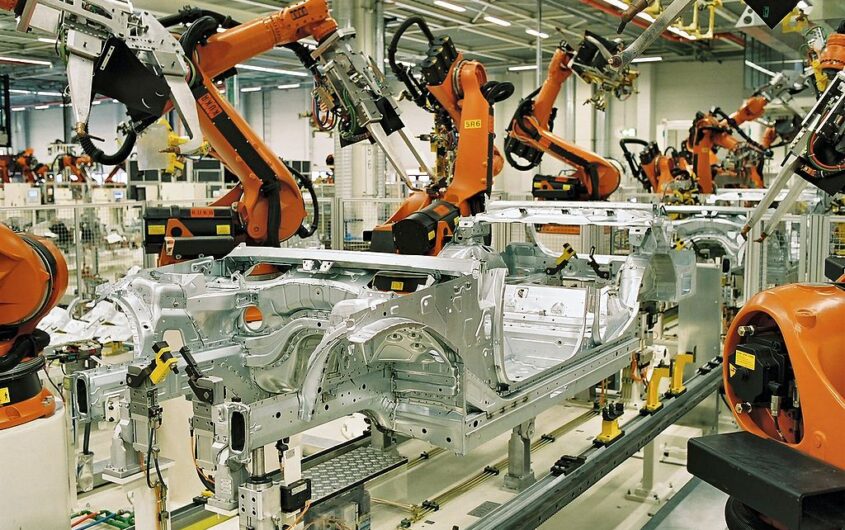
BMW Werk Leipzig via Wikimedia Commons
The German Puzzle

Holger Schmieding
Berenberg Bank
Dr Holger Schmieding is Chief Economist at Berenberg in London. Before joining Berenberg in October 2010, Holger worked as Chief Economist Europe at Merrill Lynch, Bank of America and Bank of America-Merrill Lynch in London. Having studied economics in Munich, London and Kiel, he holds a doctorate from the University of Kiel. Prior to this, he also worked as a journalist at Westfälische Nachrichten in Germany, as head of a research group on east-central Europe at the Kiel Institute of World Economics and as a desk economist at the International Monetary Fund in Washington, DC.
What is wrong with Germany? The erstwhile powerhouse of Europe has turned into the only major economy that looks set to contract in 2023. The export machine is stumbling, residential construction is plunging, voters are restive, and businesses complain about excessive energy costs, rising regulatory burdens, and pervasive policy uncertainty. Some observers have even started to call Germany the “sick man of Europe” again, a label I had introduced for the country in 1998 well before The Economist turned it into a cover story a few months later. Only when the “Agenda 2010” reforms of 2003/2004 put Germany on the right track again could I ditch the label.
Today, Germany is indeed facing serious challenges again. Held back by pervasive labor shortages, it is the victim of its previous success almost as much as of policy mistakes and ingrained inertia. However, the current wave of pessimism is vastly overdone.
Many observers make two mistakes: (i) they fail to distinguish between short-term cyclical gyrations caused by fluctuations in demand or external shocks and the longer-run trend shaped by domestic supply-side policies, and (ii) they misunderstand the nature of the German economy.
Start with the cycle. Because many German companies have specialized in the export of highly cyclical goods such as cars, machine tools, and chemicals, Germany is more exposed to the current downturn of the global manufacturing cycle than other economies. However, the global trimming of manufacturing inventories will likely have run its course by late 2023. In addition, the 8 percent year-over-year fall in German exports to China in the first half of 2023 will likely give way to small gains again in 2024. Even a less vigorous Chinese economy will record some growth again in the future once the current correction of investment excesses has run its course. The likely end of the recent downturn in U.S. manufacturing in 2024 will also boost demand for German goods again.
By spring 2024, the nascent recovery in domestic consumer spending underpinned by lower inflation and higher wage gains will likely gather pace. Pent-up demand for business investment to restructure supply chains, replace scarce labor, and reduce their use of energy will add momentum. In addition, the government is stepping up its spending on public investment and the military. Short of a new major shock, Germany could return to a solid upswing backed by all major components of demand by mid-2024. That could dispel much of the current pessimism.
As long as [Germany’s Mittelstand] works, Germany can cope with even major structural shifts.
Now consider the nature of the German model. For decades, observers have alternatively seen Germany’s export prowess and its reliance on specific manufacturing sectors such as the car industry as either the key strength or weakness of its economic model. However, the specialization in specific products is not the crucial feature of the German economy. Instead, its real drivers are the large number of small and medium-sized companies. Taken together, they are one of the best search engines for innovation ever invented. In Germany’s highly diverse Mittelstand, a huge number of small companies, often directed by the survival instincts of their owners, are constantly looking for new opportunities in almost every conceivable direction. The more they do so, the more such opportunities they will find. Germany is the global champion of “hidden champions” that often dominate tiny niches of the global market. They have coped with many serious transitions before and will likely do so again unless politics gets in the way badly.
As long as this search engine for thousands of new opportunities works, Germany can cope with even major structural shifts such as those away from textiles and steel in the past, or now away from carbon-powered cars and cheap fossil fuels.
Being home to the Mittelstand search engine is no guarantee for a strong economy. The key question is whether these—and other—companies decide to create jobs at home or abroad. When Germany overburdened itself with the costs of unification in the 1990s, it turned into an unattractive place to invest and create jobs. Reacting to its problems with a series of sweeping reforms from 2003 to 2005, the country then set the stage for the “golden decade” I predicted in a major research report in 2010. As success has bred complacency, Germany has indeed started to lose some ground in the last few years. No surprise in that. However, Germany’s current situation differs starkly from that in the late 1990s when the country was indeed turning into the “sick man of Europe.”
- Thanks to the labor market reforms of 2003-2005, Germany is enjoying record employment instead of a 1990s-style surge in unemployment. That makes it much easier to accept structural change, for instance in response to higher prices for fossil fuels, as workers who may lose their jobs in some sectors have a much better chance of finding new jobs than ever since the late 1960s. German energy prices are high, but not much higher than in most of the rest of Europe.
- Some twenty-five years ago, Germany was on course to become, jointly with France, the first major economy to breach the Maastricht 3 percent fiscal deficit limit. Thanks to a 32 percent rise in core employment (the number of people earning enough to be subject to payroll taxes) since early 2006, Germany now enjoys the most comfortable fiscal position of all major economies.
- In contrast to the period of 1995-2002, when the center-left parties of the political establishment obstructed all serious attempts to reform the country, major players in government and the mainstream opposition now agree that significant changes are needed. Parliament already passed laws to attract qualified immigrants with a Canada-style “points system” and lighten the tax burden modestly for companies. Having already shortened planning, approval, and judicial review processes for critical infrastructure projects such as the LNG terminals that were built in record time after Putin shut down gas supplies, a law to accelerate such procedures for further projects is in the making.
All in all, that bodes well for the outlook for reforms. Germany is no longer Europe’s star performer. But it is still in much better shape than the pessimists suggest.
For more background, see the recent Berenberg report, “The German economy: what is the problem?”









